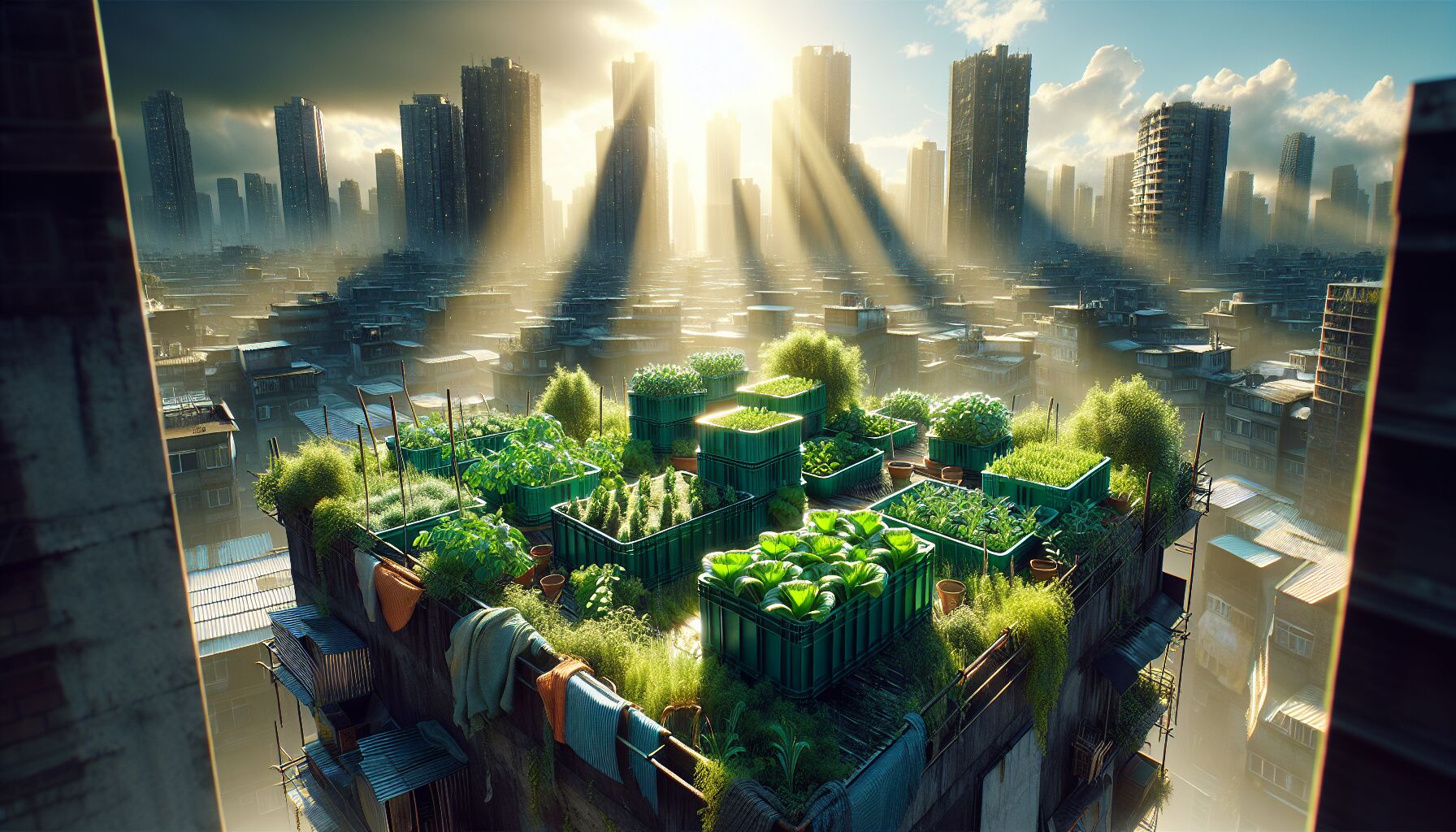 Forget the picture-perfect Pinterest gardens—urban agriculture is grit, grit with purpose. On the surface, it’s just growing food in city spaces. But if you scratch the soil a little deeper, it’s a quiet rebellion against food scarcity, economic disparity, and environmental neglect. Rooftop greens, vacant lot farms, balcony herbs—all of it adds up to something surprisingly vital: resilient food systems that can stand their ground when industrial supply chains start cracking.
Forget the picture-perfect Pinterest gardens—urban agriculture is grit, grit with purpose. On the surface, it’s just growing food in city spaces. But if you scratch the soil a little deeper, it’s a quiet rebellion against food scarcity, economic disparity, and environmental neglect. Rooftop greens, vacant lot farms, balcony herbs—all of it adds up to something surprisingly vital: resilient food systems that can stand their ground when industrial supply chains start cracking.
Here’s the thing. The average head of lettuce travels over 1,500 miles before landing on a shelf. And every link in that chain—diesel, packaging, storage, transport—adds both carbon to the atmosphere and cost to your grocery bill. Urban agriculture gives us a chance to shorten that chain, cut the distance, and grow food where people live and need it most. Every abandoned lot turned into a tomato patch is a step toward food security—real, day-to-day nourishment born from the land under our feet.
Now don’t get lost in the romanticism. Urban food systems are not some utopian fix—it’s more like weaving an invisible net under communities that have consistently been left out of the industrial ag economy. Think about places with food deserts, where corner stores peddle expired canned soup and bruised apples wrapped in plastic. Urban agriculture doesn’t just bring food closer, it brings agency—people growing what they need, how they want it, right in their own neighborhoods.
“He who controls the food supply controls the people.” — Henry Kissinger
The wisdom here? Self-reliance means sovereignty. And sustainable cities won’t be engineered from tech hubs or policy briefs alone—they’ll be grown, season by season, from within.
What’s also fascinating is how these micro-farms function like biological acupuncture across densely built spaces. They cool hot concrete corridors, restore life to exhausted soils, invite pollinators back to sterile grids. They stitch ecological repair into the very fabric of the city—quietly, steadily, without applause. Even small operations—say, one tenth of an acre—can yield thousands of pounds of produce annually, not only feeding people but creating income, reducing emissions, and rebuilding soil health.
You’ll occasionally hear cynics grumble: “Sure, cute kale patch—but will it feed a city?” Valid concern if you think monoculture-scale means success. But urban agriculture’s value isn’t just volume—it’s access, distribution, and resilience. Take a city like Detroit—over 1,500 community gardens dot its blocks, many of which help address both food access and healing from historical economic collapse. Urban farms not only nourish bodies, they repair land and story.
Plus, urban farms often double as community hubs. They spark education, mental well-being, and skill-building. Kids learn where real food comes from. Elders pass down traditions. Families reconnect with rhythms beyond the algorithm. And when the shelves are bare—during storms, economic collapse, freight issues—localized growing isn’t a hobby, it’s a lifeline.
“The ultimate goal of farming is not the growing of crops, but the cultivation and perfection of human beings.” — Masanobu Fukuoka
If you’re someone attuned to cycles—the lunar gardeners, soil whisperers, the ones who feel the seasons under their skin—you already know this instinctively. Urban agriculture is about restoring balance. Not just in the ground, but in our relationships—with food, land, and each other.
On the numbers side, there’s solid science backing this. According to the National Institutes of Health, urban agriculture has measurable benefits on food security outcomes, especially in low- to middle-income neighborhoods. In parallel, organizations like the U.S. Department of Energy have begun recognizing the synergy between renewable energy systems and urban farming, especially with greenhouse and vertical farming tech powered by solar.
So when someone scoffs at a backyard compost pile or a milk crate full of chard, don’t blink. These small plots are seeds of systemic resilience, not cute curiosities. And each harvest is a quiet reminder: we’re more powerful—and less dependent—than we’ve been led to believe.
Challenges faced by urban farming initiatives
Let’s be real—urban farming doesn’t happen in some frictionless vacuum of good intentions and community spirit. You put your hands in the dirt of a city, and you don’t just hit compost. You hit regulations, zoning headaches, skeptical landlords, soil laced with lead, and more red tape than a city budget hearing.
Access to land, first off, is a riddle inside a maze. Many urban farmers don’t own the land they grow on. They patch together leases, handshake agreements, or borrow space that can evaporate overnight. A development deal rolls through, and suddenly, that lush little ecosystem turns into a coffee chain parking lot. It’s hard to build food security on land that can be reclaimed at the stroke of a pen.
Then there’s the issue of soil contamination. Urban soil carries a memory—often a toxic one. Old factories, gas stations, and dumping grounds have left behind a legacy of heavy metals and chemicals that don’t just “go away” because you planted tomatoes. Remediating soil safely is possible (with things like mycoremediation or raised-bed methods), but it takes time, knowledge, and resources that many underfunded growers don’t have.
“Knowledge is power, but enthusiasm pulls the switch.” — Ivern Ball
That enthusiasm shows up every day in farmers who adapt, test, learn, and trial new methods—herbal borders that deter pests without poison, rainwater catchment systems that skirt municipal bills, and interplanting techniques borrowed from Indigenous traditions. But enthusiasm can only go so far when there’s no funding cushion. Most urban ag projects rely on grants, volunteers, and patchy donations—unsustainable cycles that leave crucial work hanging by a financial thread.
And speaking of money, economic sustainability is another uphill climb. Running a farm is a full-time job, even if it’s squeezed between skyscrapers. But few city growers can live off farm income alone. Maybe they run a CSA, sell at local markets, or partner with restaurants, but the margins are razor-thin. Urban ag needs a viable economic framework—fair pricing, local procurement programs, and access to microfinance—not just applause and awards.
Now, let’s talk water. Some cities charge commercial rates for irrigation. Others restrict water access entirely for non-residential plots. It’s ironic: plants soak sun and rain, but urban policy can dry out a harvest before it even sprouts. Pair that with pest pressure in warmed-up microclimates and you’re dealing with both ecological and bureaucratic stressors. And the irony? Those who most need the food—low-income, climate-vulnerable communities—often face the highest hurdles trying to grow it.
There’s also the matter of community fatigue. Not everyone in a neighborhood will rally around a community garden. In places where historical neglect runs deep, people can be rightfully suspicious of projects that roll in with nice signage and press releases, only to fizzle out or get co-opted later. A garden, no matter how lush, doesn’t stand on roots of kale alone. It needs trust, consistency, and cultural respect.
Throw in lack of institutional support, and it becomes clear—urban ag isn’t failing; it’s being failed. Schools want to teach sustainability but have no green space. Cities draft “sustainable cities” plans that leave gardens off maps. Planning departments may categorize urban farms as community events, not infrastructure. And food security suffers as the disconnect widens.
Still, it’s not all roadblocks—just open eyes. When these challenges are acknowledged outright, the road gets more navigable. Solutions start forming, not from outsiders parachuting in, but from within: neighbors sharing seed, elders passing on gardening wisdom, students building hydroponics in school basements. It’s messy, unglamorous, and radically hopeful.
And honestly, that’s the soul of urban agriculture. It holds a mirror to the gaps in our systems—but it doesn’t stop there. It grows something new in those cracks. Something rooted, not just aimed at survival, but at real sovereignty inside sustainable cities.
If you’re in the work right now—tarping abandoned lots, hauling compost, navigating zoning codes, dealing with skeptical city councils—hold the line. You’re not just growing food. You’re helping rebuild a broken loop—connecting care, place, and nourishment in one stubborn, living system. That’s not failure. That’s fermentation.
Policy recommendations to support urban farms
 Policy can build or break a garden before the first seed even hits the soil. That’s not drama—it’s just the weird truth of how urban agriculture lives or dies in a bureaucratic world. And if the goal is genuine food security, not just buzzwords on press releases, then the system needs to start pulling in the same direction as the people doing the actual growing.
Policy can build or break a garden before the first seed even hits the soil. That’s not drama—it’s just the weird truth of how urban agriculture lives or dies in a bureaucratic world. And if the goal is genuine food security, not just buzzwords on press releases, then the system needs to start pulling in the same direction as the people doing the actual growing.
Let’s begin where many city growers get stuck: land tenure. Permanence is power. Without long-term access to land, urban farmers hesitate to build infrastructure, plant fruit trees, or make generational commitments to soil improvement. Cities can step in as allies here by establishing land trusts, adopting zoning protections for urban farms, and converting long-vacant public lands into protected food-growing spaces. Models like the Urban Tilth in Richmond, California, or the Boston Urban Agriculture Rezoning Initiative, are proof it’s not just theory—it works.
But access alone won’t cover it. Even the most passionate grower can’t pay the water bill with compost. Local governments can support food-growing operations by integrating them into economic development plans—not as side projects, but as critical community infrastructure. That includes:
- Subsidizing or waiving water fees for food-producing green spaces
- Offering tax incentives for landowners who provide space to community farms
- Developing procurement programs that prioritize urban farm produce in public schools, hospitals, and shelters
You want sustainable cities? Start by helping them feed themselves. It’s not everything, but it’s foundational. Food grown in your zip code, by people in your neighborhood, nourishes more than a body—it nourishes a sense of place.
And now, the money piece. Grants help, but they’re competitive, time-consuming, and often detached from those actually growing the food. Instead of throwing short-term funds at flashy pilot projects, what if municipalities rerouted a fraction of their public health budgets toward ongoing operational support for proven urban agriculture efforts? Preventing chronic disease through local food access is a whole lot cheaper—and more human—than treating it downstream.
“You measure the health of a society by how it treats its soil and its seed.” — Vandana Shiva
That health isn’t just yield metrics and soil tests. It’s mental health, too. Community gardens and small farms are sanctuaries in noise-heavy, screen-lit urban life. They’re spaces where elders feel useful and children remember that carrots come from the earth, not from plastic bags. And yet, mentorship programs, green worker training, and multi-language education models often lack funding, even though those touchpoints are what anchor projects long-term.
Let’s also talk education reform. Most school systems teach food systems like stock charts—abstract and distant—and barely touch soil. But when urban farms become living labs, the curriculum writes itself. Municipalities and counties could fund garden educators like they fund sports coaches. Imagine schools where lunchtime includes harvesting kale, prepping it, and sharing salad—not to decorate wellness programs, but because it’s deeply educational and incredibly grounding.
Policy change also means lifting the moral fog from food justice work. We’ve got to stop treating community agriculture like charity, and start recognizing it as an act of civic ecology. That means integrating urban ag into climate resilience plans, emergency food systems, and even affordable housing frameworks—so the people who grow the food can also afford to live near it.
Right now, in cities like Philadelphia, Portland, and Atlanta, farmers are partnering with local agencies to pilot “Green Workforce” pipelines—training programs in composting, aquaponics, soil testing, herbalism, and small business ownership. It’s powerful. But it needs consistency, not just enthusiasm. Institutional policy should recognize these farms as employers, not just volunteers with good intentions.
And finally, a note on narrative power. Policy isn’t always about laws—it’s about how we choose to see. When officials refer to gardens as “interim land use,” it signals disposability. But when they call them “critical infrastructure”—on par with roads or fire departments—funding flows. Respect grows. Communities lean in. It’s a subtle shift, but it moves mountains.
So, what’s it going to take? Persistence. Policy wonks who’ve touched soil. Farmers who speak truth in city council chambers. Thoughtful neighbors who understand that a zucchini patch might feed their kids next year when the trucks don’t show up. Real food security—especially in sustainable cities—means creating structures that nourish both the crop and the crop rotation, the grower and the ground.
You want real change? Make urban agriculture a policy priority, not a decorative line item. Otherwise, we’re planting seeds with no soil—and expecting them to bloom anyway.
 DS Haven In Light Of Things
DS Haven In Light Of Things





